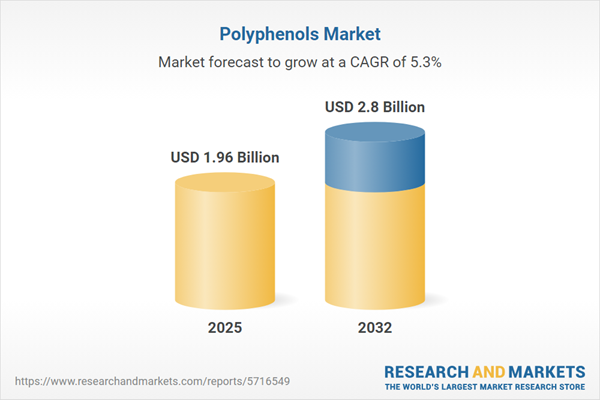Speak directly to the analyst to clarify any post sales queries you may have.
Senior decision-makers in the polyphenols market must navigate a landscape where innovation, regulation, and shifting consumer demand shape strategies for sustained growth and operational resilience. In this sector, clear, actionable insights remain integral to securing market advantage and informed business leadership.
Market Snapshot: Polyphenols Market Outlook and Growth Directions
The global polyphenols market stands at USD 1.86 billion in 2024 and is forecast to reach USD 2.80 billion by 2032, reflecting a Compound Annual Growth Rate (CAGR) of 5.25%. Expansion is propelled by rising demand from nutrition, beverage, and personal care industries, as organizations evolve to meet consumer preferences for health-focused and clean-label offerings. Technological advances, particularly in extraction processes, have enabled greater product differentiation, while regional regulatory differences and diverse consumer habits compel companies to remain agile and responsive. Success belongs to organizations attuned to emerging trends and compliance landscapes, positioning themselves to lead amid ongoing change.
Scope & Segmentation: Comprehensive Polyphenols Market Coverage
- Applications: Polyphenols are used across dietary supplements, functional foods, beverages, bakery, confectionery, snacks, dairy, pharmaceutical, and personal care sectors. Their wide application base allows for innovation aligned with evolving health and wellness expectations.
- Sources: Key supply sources include berries, cocoa, tea, wine, citrus fruits, and leafy vegetables. This diversity allows procurement teams to develop risk-mitigating strategies and address environmental factors in supply chain management.
- Forms: Available in capsules, powders, liquids, softgels, and tablets, polyphenols leverage processing and delivery technologies to meet clinical and nutritional market needs, creating new opportunities for product launches.
- Product Types: Flavonoids, phenolic acids, stilbenes, and lignans each offer distinct health and technical characteristics, supporting entry into specialized market segments and compliance with region-specific standards.
- Distribution Channels: Sales strategies span direct and indirect channels, including online platforms, supermarkets, hypermarkets, drug stores, pharmacies, and specialty retailers, ensuring broad market penetration and access to targeted customer groups.
- Regional Coverage: Significant markets include the Americas, Europe, Middle East, Africa, and Asia-Pacific. Local regulation, innovation pace, and competitive activity—especially in China, India, and Japan—require tailored entry and expansion approaches.
- Key Companies: Givaudan SA, Koninklijke DSM N.V., Archer-Daniels-Midland Company, International Flavors & Fragrances Inc., Indena S.p.A., Euromed S.A., Kalsec Inc., PLT Health Solutions, Inc., Sabinsa Corporation, and ChromaDex Corporation stand out for their influence and benchmarks in the sector.
Key Takeaways: Strategic Insights for Polyphenols Market Leadership
- Consumer momentum for clean-label and plant-based products is raising expectations for transparent sourcing, making compliance monitoring and supplier visibility essential throughout procurement operations.
- Technology innovations in polyphenols extraction and analytics provide a competitive edge, allowing businesses to expand applications and tailor products for both clinical and wellness markets.
- Harmonization of regulatory frameworks supports smoother market entry, enabling organizations to remain flexible and aligned as policies evolve worldwide.
- Growth in digital wellness platforms supports rapid adaptation to consumer needs, empowering companies to address emerging trends and diversify within health-related markets.
- Collaboration between procurement, research, and operations teams secures robust traceability, strengthens supply chain adaptability, and helps mitigate risks from sudden disruptions.
- Localization of sourcing strategies and supplier partnerships enhance business stability, protecting organizations from volatility related to market or geopolitical shifts.
Tariff Impact: Adaptation Strategies in a Changing Trade Environment
In the context of evolving global trade dynamics, polyphenols manufacturers are reinforcing regionally integrated supply networks and expanding supplier portfolios. Approaches such as negotiated long-term contracts and dynamic inventory methods are effective in managing tariff variability, sustaining supply reliability and consistent product availability despite regulatory shifts.
Methodology & Data Sources
This report synthesizes authoritative scientific literature, specialized industry databases, and stakeholder interviews. Data triangulation is applied to ensure findings remain accurate and relevant as regulatory landscapes and industry standards develop.
Why This Report Matters: Executive Value in Polyphenols Market Analysis
- Segmented market analysis informs investment strategies and supports proactive adjustments to supply chains, promoting operational agility.
- Ongoing monitoring of trends enables executive teams to align portfolios with evolving regulations and emerging growth channels.
- Clarity in supplier risk and expansion options provides leadership with confidence when entering new markets or diversifying product categories.
Conclusion
This polyphenols market analysis equips leaders with the insights to manage risks, refine business strategies, and capitalize on current and emerging opportunities within this dynamic sector.
Additional Product Information:
- Purchase of this report includes 1 year online access with quarterly updates.
- This report can be updated on request. Please contact our Customer Experience team using the Ask a Question widget on our website.
Table of Contents
3. Executive Summary
4. Market Overview
7. Cumulative Impact of Artificial Intelligence 2025
Companies Mentioned
The companies profiled in this Polyphenols market report include:- Givaudan SA
- Koninklijke DSM N.V.
- Archer-Daniels-Midland Company
- International Flavors & Fragrances Inc.
- Indena S.p.A.
- Euromed S.A.
- Kalsec Inc.
- PLT Health Solutions, Inc.
- Sabinsa Corporation
- ChromaDex Corporation
Table Information
| Report Attribute | Details |
|---|---|
| No. of Pages | 195 |
| Published | October 2025 |
| Forecast Period | 2025 - 2032 |
| Estimated Market Value ( USD | $ 1.96 Billion |
| Forecasted Market Value ( USD | $ 2.8 Billion |
| Compound Annual Growth Rate | 5.2% |
| Regions Covered | Global |
| No. of Companies Mentioned | 11 |









